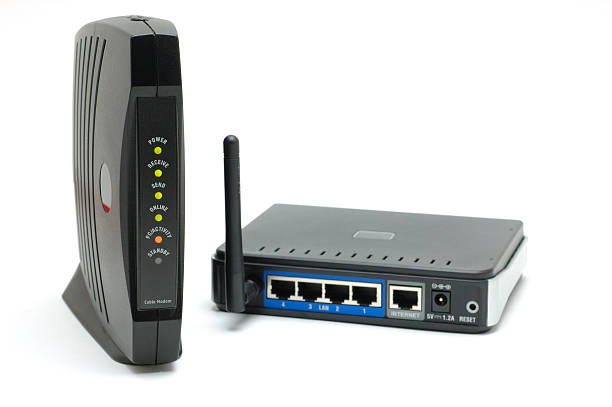Home networks have become an indispensable part of modern living, and the heart of these networks lies within two components: the modem and router. These separate devices are often confused with each other due to their interconnected roles. A modem connects directly to internet services provided usually through cable lines or fiber, translating raw data into a readable format for devices. On the other hand, a router connects multiple devices within the home, allowing multiple users and gadgets to access the translated data sent from the modem. Without these devices, the convenience of internet access would falter, leaving users disconnected from the digital world they have become so reliant upon.
Essential Networking Devices: Modems and Routers
While it’s possible for consumers to only have one device that acts as both a modem and a router, often called router combos, usually, a robust home network will need two separate components. There are numerous benefits to having two separate devices, such as improved performance and more customized network configurations. Here are key roles these devices play:
- Modem: Connects to your Internet Service Provider (ISP), translating signals for two-way Internet communication via wired connections.
- Router: Acts as a central hub for your local network, managing and distributing Wi-Fi signals or wired connections to multiple devices.
The Role of Each Device in the Digital Age
The modem is where it all begins—it brings the internet into your home. The name ‘modem’ is short for modulator-demodulator, and its job is to convert digital signals from your ISP into analog signals that can travel over phone or cable lines, and vice versa. But, having internet access flowing into your home is only the first step. This is where the router steps in—it orchestrates the distribution of internet data to various devices in your home, creating a network that allows multiple devices to enjoy internet access simultaneously.

Diving Into the Functionality of a Modem
What exactly is a modem? It’s a bridge between your local network and the colossal world of the internet. In the early days of the internet, modems were separate devices that could only provide internet access to a single computer. As internet speeds raced ahead, the function of modems evolved, but their essential purpose did not—they still serve as the initial point of contact between your home and the broader internet. Without a modem, you cannot translate the signals from your ISP, and thus, cannot connect to the internet.
- Connection to ISP: A modem connects to your ISP through traditional phone lines, DSL, or cable lines.
- Data Translation: The data from your ISP does not come in a format readily usable by your devices, but the modem translates it into a digital format that devices can understand.
Here’s a practical look at a standard modem’s attributes:
| Function | Description |
|---|---|
| Connectivity | Simplifies cable lines or fiber connections from the ISP |
| Signal Conversion | Translates analog signals into digital ones and vice versa |
| Single-Device Access | Connects to one device for internet access without routing capabilities |
How Does a Modem Work?
A modem’s primary purpose is to facilitate communication with your ISP. By taking in analog signals from the ISP through cable lines, it converts these signals into a digital format that your device can understand and use to connect to the internet. But a modem’s purpose stops there—it does not route or distribute this connection to other devices. Therefore, if you only needed an internet connection for a single device, a modem alone might suffice, but in today’s digital age, that is seldom the case.
Exploring the Capabilities of a Router
If modems are the translators of internet signals, routers are the distributors. A router is a more advanced device that not only allows multiple devices to use a single internet connection but can also manage and prioritize traffic, ensuring stability and security. When you’re doing so, it’s important to remember that a router does not bring the internet to your home—that’s the modem’s work. Instead, a router creates a network among the devices inside the home or office, sometimes offering both wired connections and wireless access through Wi-Fi signals.
The Router’s Role in Network Management
The true prowess of a router lies in its ability to connect multiple devices, creating a coherent network where information is shared seamlessly. Think of a router as the conductor of an orchestra, ensuring each instrument plays in harmony. When a device tries to communicate over the network, the router directs the incoming and outgoing traffic, preventing bottlenecks and optimizing the flow. It’s also responsible for securing your network, safeguarding your communications with firewalls and password protection. Without routers, maintaining a safe and efficient network for multiple devices would be a challenge.
Distinct Functions and Purposes
The differences between a modem and a router are not just technical; they are also practical. A modem is your gateway to the world wide web, a single-purpose conduit ensuring you can receive internet services. A router, conversely, manages the local traffic within your private network and connects multiple devices, allowing them to communicate with each other and the internet. While both are involved in the process of delivering internet access, their functions are distinctly separate:
- Modem: Solely facilitates your connection to the internet.
- Router: Distributes internet access to various devices and manages your local network traffic.
Physical and Performance Differences
Observing modems and routers from a physical standpoint reveals that they are often quite distinguishable. Modems generally have fewer ports since they typically service a single device. Routers, with the need to accommodate multiple devices, boast a series of Ethernet ports, as well as wireless capabilities, for devices to connect. Routers have more sophisticated firmware that can include advanced features such as VPN support, traffic analysis, and even mesh networking capabilities for expanded coverage across a larger area.

Use Cases: Modem vs. Router in Real Life
To truly grasp the applications of these devices in daily life, consider the following scenarios:
- When you only have one device that needs internet access and are not concerned about creating a local network, a standalone modem would suffice. However, such cases are quite rare today as most individuals and households operate multiple devices.
- For a family or an individual with smart devices, laptops, tablets, and phones all requiring simultaneous internet access, a router becomes necessary. The router connects multiple devices, providing access to the internet through the modem, and does so with the convenience of wireless networking.
Here are instances that highlight the interdependence of modems and routers in today’s digital landscape:
- When Do You Need a Modem? Whenever you require a connection to the internet, a modem is your indispensable tool. It’s especially crucial if you’re operating a single device with wired internet access.
- The Versatility of Routers in Home Networks: Home networks benefit greatly from routers when there are multiple users or devices. If your household indulges in online gaming, video streaming, or has a need for robust internet security, a router is the go-to device.
Conclusion
Exploring the techno-scape of modems and routers reveals a clear demarcation in the role each plays in our interconnected existence. Their differences are as pivotal as their functions; while a modem could not bridge the divide between digital data and accessible internet without the router to direct traffic, routers would have no data to distribute without a modem’s conversion capabilities. As the internet continues to evolve, so too will these devices, each maintaining its critical role in our discussions, discoveries, and daily lives. Understanding the complexity of modems and routers allows us to appreciate the silent orchestration behind our seamlessly connected experiences.

FAQs
What happens if I only use a modem without a router?
If you use a modem without a router, you can only connect one device directly to the internet via wired connection. This means you cannot establish a local network to connect multiple devices wirelessly.
Can I connect multiple devices using just a modem?
No, a modem does not have the capability to distribute internet access to multiple devices. For connecting several devices, you will need a router paired with your modem.
Do I need a separate modem and router if my ISP provides a combined device?
If your ISP provides a device that is both a modem and a router (commonly known as a gateway), you do not need separate devices. These combos may be sufficient for your needs, but owning separate devices might offer more flexibility and performance in some scenarios.
How do I know if I need to upgrade my modem or router?
You may need to upgrade your modem or router if you’re experiencing slow internet speeds, your current equipment is outdated and doesn’t support the latest internet standards or Wi-Fi technologies, or you’re adding more devices to your network and need better management and coverage.
Is it better to buy a modem and a router separately or as a combined unit?
Whether it’s better to buy a modem and router separately or as a combination depends on your specific needs. Separate devices offer more flexibility and may provide better performance, while combo units are convenient and can save space and outlets. It’s best to assess your internet habits and future needs before deciding.



